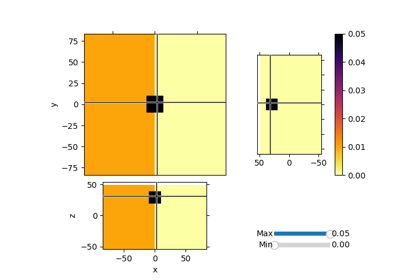simpeg.maps.SurjectUnits#
- class simpeg.maps.SurjectUnits(indices, **kwargs)[source]#
Bases:
IdentityMapSurjective mapping to all mesh cells.
Let \(\mathbf{m}\) be a model that contains a physical property value for nP geological units.
SurjectUnitsis used to construct a surjective mapping that projects \(\mathbf{m}\) to the set of voxel cells defining a mesh. As a result, the mapping \(\mathbf{u(\mathbf{m})}\) is defined as a projection matrix \(\mathbf{P}\) acting on the model. Thus:\[\mathbf{u}(\mathbf{m}) = \mathbf{Pm}\]The mapping therefore has dimensions (mesh.nC, nP).
- Parameters:
- indices(
nP)listof(mesh.nC)numpy.ndarray Each entry in the
listis a booleannumpy.ndarrayof length mesh.nC that assigns the corresponding physical property value to the appropriate mesh cells.
- indices(
Attributes
Projection matrix from model parameters to mesh cells.
List assigning a given physical property to specific model cells.
Determine whether or not this mapping is a linear operation.
The mesh used for the mapping
Number of parameters the mapping acts on.
Dimensions of the mapping
Methods
deriv(m[, v])Derivative of the mapping with respect to the input parameters.
dot(map1)Multiply two mappings to create a
simpeg.maps.ComboMap.inverse(D)The transform inverse is not implemented.
test([m, num, random_seed])Derivative test for the mapping.
Examples
For this example, we have a model that defines the property values for two units. Using
SurjectUnit, we construct the mapping from the model to a 1D mesh where the 1st unit’s value is assigned to all cells whose centers are located at x < 0 and the 2nd unit’s value is assigned to all cells whose centers are located at x > 0.>>> from simpeg.maps import SurjectUnits >>> from discretize import TensorMesh >>> import numpy as np
>>> nP = 8 >>> mesh = TensorMesh([np.ones(nP)], 'C') >>> unit_1_ind = mesh.cell_centers < 0
>>> indices_list = [unit_1_ind, ~unit_1_ind] >>> mapping = SurjectUnits(indices_list, nP=nP)
>>> m = np.r_[0.01, 0.05] >>> mapping * m array([0.01, 0.01, 0.01, 0.01, 0.05, 0.05, 0.05, 0.05])

